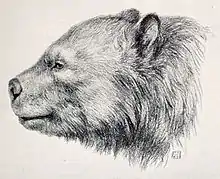Arctotherium
Arctotherium ("bear beast") is an extinct genus of Pleistocene South American short-faced bears within Ursidae.[1] Their ancestors migrated from North America to South America during the Great American Interchange, following the formation of the Isthmus of Panama during the late Pliocene. The oldest dated confirmed remains are those of A. angustidens from Buenos Aires, Argentina, dating to the Ensenadan epoch, 1.76 to 0.98 Ma old, within the Early to Middle Pleistocene,[1] with a tooth possibly belonging to Arctotherium dating about 2.588 Mya. They are genetically closer to the spectacled bear (Tremarctos ornatus), than to Arctodus of North America, implying the two extinct forms evolved large size in a convergent manner, perhaps to facilitate dominating other carnivores in the competition for the biggest carcasses.[2] The northernmost species, A. wingei, known from Venezuela in South America,[1] apparently invaded Central America and reached as far north as the Yucatán.[3]
| Arctotherium | |
|---|---|
 | |
| Life restoration of A. bonariense | |
| Scientific classification | |
| Kingdom: | Animalia |
| Phylum: | Chordata |
| Class: | Mammalia |
| Order: | Carnivora |
| Family: | Ursidae |
| Subfamily: | Tremarctinae |
| Genus: | †Arctotherium Bravard 1857 |
| Type species | |
| †Arctotherium (Arctotherium) bonariense Gervais 1852 | |
| Species | |
Description
Arctotherium was named by Hermann Burmeister in 1879. A specimen of A. angustidens from Buenos Aires shows an individual estimated, using the humerus, to weigh between 983 and 2,042 kg (2,167 and 4,502 lb), though the authors consider the upper limit as improbable and say that 1,588 to 1,749 kg (3,501 to 3,856 lb) is more likely. An estimated standing height for Arctotherium is 3.4–4.3 metres (11–14 ft). It would still make the genus the largest bear ever found and contender for the largest carnivorous land mammal known.[4]
Its large size has been attributed to increased competition from other, later-arriving or evolving carnivorans, such as jaguars, or Smilodon, following the early dispersal of short-faced bears to South America.[4] The North American carnivorans that invaded South America, including short-faced bears and Smilodon, probably quickly dominated the predatory niches formerly occupied by the native typical South American groups such as metatherian sparassodont and avian phorusrhacid carnivores.
Ecology
There is evidence to suggest that Arctotherium had dens.
Distribution
Fossils of Arctotherium have been found in:[5]
- Blancan
- Quaternary
- Luján Formation, Argentina
- Taríja and Ñuapua Formations, Bolivia
- Jandaíra Formation, Brazil
- Cueva de los Chingues, Chile[7]
- Sistema Sac Actun, Yucatán, Mexico[3]
- Taima-Taima, Muaco and Cueva del Guácharo, Venezuela[8]
References
- Soibelzon, L.H.; Tonni, E.P.; Bond, M. (2005). "The fossil record of South American short-faced bears (Ursidae, Tremarctinae)". Journal of South American Earth Sciences. 20 (1–2): 105–113. Bibcode:2005JSAES..20..105S. doi:10.1016/j.jsames.2005.07.005. Retrieved 2019-02-21.
- Mitchell, K. J.; Bray, S. C.; Bover, .; Soibelzon, L.; Schubert, B. W.; Prevosti, F.; Prieto, A.; Martin, F.; Austin & Alan Cooper, J. J. (2016). "Ancient mitochondrial DNA reveals convergent evolution of giant short-faced bears (Tremarctinae) in North and South America". Biology Letters. 12 (4): 20160062. doi:10.1098/rsbl.2016.0062. PMC 4881349. PMID 27095265.CS1 maint: numeric names: authors list (link)
- Schubert, B. W.; Chatters, J. C.; Arroyo-Cabrales, J.; Samuels, J. X.; Soibelzon, L. H.; Prevosti, F. J.; Widga, C.; Nava, A.; Rissolo, D.; Erreguerena, P. L. (2019). "Yucatán carnivorans shed light on the Great American Biotic Interchange". Biology Letters. 15 (5): 20190148. doi:10.1098/rsbl.2019.0148. PMC 6548739. PMID 31039726. 20190148.
- Soibelzon, L.H.; Schubert, B.W. (2011). "The Largest Known Bear, Arctotherium angustidens, from the Early Pleistocene Pampean Region of Argentina: With a Discussion of Size and Diet Trends in Bears". Journal of Paleontology. 85 (1): 69–75. CiteSeerX 10.1.1.870.2014. doi:10.1666/10-037.1. S2CID 129585554.
- Arctotherium at Fossilworks.org
- Soibelzon, L.H.; Romero, M.R.; Huziel Aguilar, D.; Tartarini, V.B. (2008). "A Blancan (Pliocene) short-faced bear from El Salvador and its implications for Tremarctines in South America". Neues Jahrbuch für Geologie und Paläontologie, Abhandlungen. 250: 1–8. doi:10.1127/0077-7749/2008/0250-0001. Retrieved 2019-02-21.
- Prevosti, F.J.; Soibelzon, L.H.; Prieto, A.; San Román, M.; Morello, F. (2003). "The Southernmost bear: Pararctotherium (Carnivora, Ursidae, Tremarctinae) in the latest Pleistocene of Southern Patagonia, Chile". Journal of Vertebrate Paleontology. 23 (3): 709–712. doi:10.1671/0272-4634(2003)023[0709:TSBPCU]2.0.CO;2. Retrieved 2019-02-21.
- Soibelzon, L.H.; Rincón, A.D. (2007). "The fossil record of the short-faced bears (Ursidae, Tremarctinae) from Venezuela. Systematic, biogeographic, and paleoecological implications". Neues Jahrbuch für Geologie und Paläontologie, Abhandlungen. 244 (3): 287–298. CiteSeerX 10.1.1.827.6635. doi:10.1127/0077-7749/2007/0244-0287.